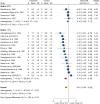Physiological effects of intraperitoneal versus subcutaneous insulin infusion in patients with diabetes mellitus type 1: A systematic review and meta-analysis
- PMID: 33848314
- PMCID: PMC8043377
- DOI: 10.1371/journal.pone.0249611
Physiological effects of intraperitoneal versus subcutaneous insulin infusion in patients with diabetes mellitus type 1: A systematic review and meta-analysis
Abstract
The intraperitoneal route of administration accounts for less than 1% of insulin treatment regimes in patients with diabetes mellitus type 1 (DM1). Despite being used for decades, a systematic review of various physiological effects of this route of insulin administration is lacking. Thus, the aim of this systematic review was to identify the physiological effects of continuous intraperitoneal insulin infusion (CIPII) compared to those of continuous subcutaneous insulin infusion (CSII) in patients with DM1. Four databases (EMBASE, PubMed, Scopus and CENTRAL) were searched beginning from the inception date of each database to 10th of July 2020, using search terms related to intraperitoneal and subcutaneous insulin administration. Only studies comparing CIPII treatment (≥ 1 month) with CSII treatment were included. Primary outcomes were long-term glycaemic control (after ≥ 3 months of CIPII inferred from glycated haemoglobin (HbA1c) levels) and short-term (≥ 1 day for each intervention) measurements of insulin dynamics in the systematic circulation. Secondary outcomes included all reported parameters other than the primary outcomes. The search identified a total of 2242 records; 39 reports from 32 studies met the eligibility criteria. This meta-analysis focused on the most relevant clinical end points; the mean difference (MD) in HbA1c levels during CIPII was significantly lower than during CSII (MD = -6.7 mmol/mol, [95% CI: -10.3 --3.1]; in percentage: MD = -0.61%, [95% CI: -0.94 -- 0.28], p = 0.0002), whereas fasting blood glucose levels were similar (MD = 0.20 mmol/L, [95% CI: -0.34-0.74], p = 0.47; in mg/dL: MD = 3.6 mg/dL, [95% CI: -6.1-13.3], p = 0.47). The frequencies of severe hypo- and hyper-glycaemia were reduced. The fasting insulin levels were significantly lower during CIPII than during CSII (MD = 16.70 pmol/L, [95% CI: -23.62 --9.77], p < 0.0001). Compared to CSII treatment, CIPII treatment improved overall glucose control and reduced fasting insulin levels in patients with DM1.
Conflict of interest statement
The authors have declared that no competing interests exist.
Figures







Similar articles
-
Intraperitoneal versus subcutaneous insulin therapy in the treatment of type 1 diabetes mellitus.Neth J Med. 2015 Nov;73(9):399-409. Neth J Med. 2015. PMID: 26582805
-
Continuous intraperitoneal insulin infusion in type 1 diabetes: a 6-year post-trial follow-up.BMC Endocr Disord. 2014 Apr 7;14:30. doi: 10.1186/1472-6823-14-30. BMC Endocr Disord. 2014. PMID: 24708696 Free PMC article. Clinical Trial.
-
Report of a 7 year case-control study of continuous intraperitoneal insulin infusion and subcutaneous insulin therapy among patients with poorly controlled type 1 diabetes mellitus: favourable effects on hypoglycaemic episodes.Diabetes Res Clin Pract. 2014 Nov;106(2):256-63. doi: 10.1016/j.diabres.2014.08.018. Epub 2014 Sep 30. Diabetes Res Clin Pract. 2014. PMID: 25305134
-
Intraperitoneal insulin infusion: treatment option for type 1 diabetes resulting in beneficial endocrine effects beyond glycaemia.Clin Endocrinol (Oxf). 2014 Oct;81(4):488-97. doi: 10.1111/cen.12546. Epub 2014 Jul 28. Clin Endocrinol (Oxf). 2014. PMID: 25041605 Review.
-
Severe hypoglycaemia and glycaemic control in Type 1 diabetes: meta-analysis of multiple daily insulin injections compared with continuous subcutaneous insulin infusion.Diabet Med. 2008 Jul;25(7):765-74. doi: 10.1111/j.1464-5491.2008.02486.x. Diabet Med. 2008. PMID: 18644063 Review.
Cited by
-
Pharmacokinetics of Intraperitoneally Delivered Glucagon in Pigs: A Hypothesis of First Pass Metabolism.Eur J Drug Metab Pharmacokinet. 2021 Jul;46(4):505-511. doi: 10.1007/s13318-021-00692-2. Epub 2021 Jun 7. Eur J Drug Metab Pharmacokinet. 2021. PMID: 34100220 Free PMC article.
-
Lipid nanoparticle structure and delivery route during pregnancy dictate mRNA potency, immunogenicity, and maternal and fetal outcomes.Proc Natl Acad Sci U S A. 2024 Mar 12;121(11):e2307810121. doi: 10.1073/pnas.2307810121. Epub 2024 Mar 4. Proc Natl Acad Sci U S A. 2024. PMID: 38437545 Free PMC article.
-
Microfluidic-based systems for the management of diabetes.Drug Deliv Transl Res. 2024 Nov;14(11):2989-3008. doi: 10.1007/s13346-024-01569-y. Epub 2024 Mar 20. Drug Deliv Transl Res. 2024. PMID: 38509342 Free PMC article. Review.
-
Pharmacokinetics of glucagon after intravenous, intraperitoneal and subcutaneous administration in a pig model.Basic Clin Pharmacol Toxicol. 2022 Jun;130(6):623-631. doi: 10.1111/bcpt.13731. Epub 2022 Apr 21. Basic Clin Pharmacol Toxicol. 2022. PMID: 35416407 Free PMC article.
-
Structural principles of insulin formulation and analog design: A century of innovation.Mol Metab. 2021 Oct;52:101325. doi: 10.1016/j.molmet.2021.101325. Epub 2021 Aug 21. Mol Metab. 2021. PMID: 34428558 Free PMC article. Review.
References
Publication types
MeSH terms
Substances
LinkOut - more resources
Full Text Sources
Other Literature Sources
Medical
Miscellaneous

